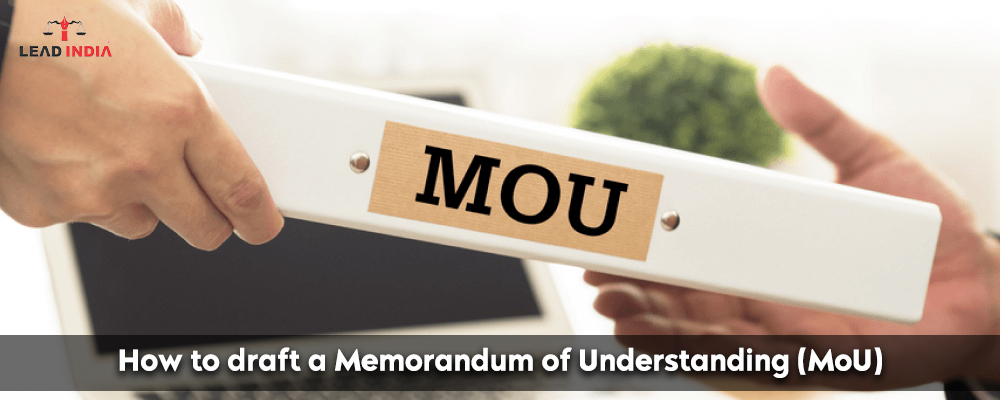The MOU can be viewed as the beginning point for negotiations because it defines the scope and goal of the discussions. These memos are most typically used in international treaty negotiations, but they can also be employed in high-stakes business deals like merger talks.
Memorandums of Understanding in Indian Law
According to Indian law, a memorandum of understanding is only enforceable in court if it complies with the provisions of the Indian Contract Act of 1872. To make an agreement valid, the parties involved in an MoU must have a legally binding relationship. If all of the prerequisites under the Indian Contract Act are met, the parties have the right to require the other party to perform the contract expressly under the Specific Relief Act of 1963, if the compensation is not measurable.
Need A Legal Advice
The internet is not a lawyer and neither are you. Talk to a real lawyer about your legal issue

Types of Memorandum of Understanding
There are two sorts of memorandums of understanding:
- A bilateral memorandum of understanding
- Multilateral memorandum of understanding
A multilateral memorandum of agreement is a deal reached by more than two parties, whereas a bilateral memorandum of understanding is a pact between two parties.
Draft a Memorandum of Understanding
- List the parties’ complete names and titles.
- Briefly describe the aim of the memorandum of understanding.
- Outline each party’s primary obligations and responsibilities.
- Describe projected deliverables or outcomes from the MoU.
- Determine a timeframe for the memorandum of understanding.
- Include any other important elements, such as confidentiality clauses, choice of law, jurisdiction, waiver of jury trial, expenses and attorney’s fees, notices, assignment, modifications, and counterparts.
- Include the important players in the project, collaboration, or partnership in the memorandum of understanding.
- Each party should sign and date the MoU with the words “Acknowledged and Agreed.”
- Have an attorney to evaluate the memorandum of understanding.
What Does a Memorandum of Understanding Between Two Parties Include?
These are the major elements found in any MoU:
- Specific points of understanding are clearly outlined in an MOU. It includes the parties’ names, the project to which they have agreed, the scope and obligations, and so on.
- Terms and Conditions: An MOU includes the agreement’s terms and conditions. All parties must agree on the terms and conditions.
- Party details: The MoU includes information on all of the parties participating in the agreement. This often comprises names, addresses, and other contact information.
- An MoU explicitly states the agreement’s objective. It also outlines the project’s duties and responsibilities, timeframe, and key dates.
- Signatures: All MoUs should include the signatures of all parties to demonstrate their agreement.
Is MoU legally binding?
In the case of Jyoti Brothers vs Shree Durga Mining Co., AIR 1956 Cal.280, the Calcutta High Court decided that the Court will consider the extent to which such an arrangement is signed between the parties and if any of them has acted in reliance on it.
What’s the difference between an MOU and a MOA?
An MOU is a document that contains broad notions of mutual understanding, goals, and strategies among the participants. In contrast, an MOA (memorandum of agreement) is a contract that details each party’s precise responsibilities and activities to be taken to achieve their goals.
What distinguishes a memorandum of understanding from a memorandum of agreement?
A memorandum of understanding (MOU) is a cooperation agreement between two parties that may include general conditions and aims but is not legally binding. A memorandum of agreement (MOA) is a more thorough commercial document that is typically written just before a legally binding contract.
Furthermore, in the well-known instance of Jai Beverages Pvt. Ltd. v. State of Jammu and Kashmir and Ors, AIR 2006(4) SCJ 401, the Supreme Court held that an MoU can be considered a legally enforceable contract if it is formal and the parties benefit from operating by the provisions specified in the MoU.
The nature of a MoU can be determined by the clauses included in the document, which indicate whether it is legally valid or enforceable. If we want to make an MoU legally binding in a court of law, we can insert clauses like Confidentiality and Dispute Resolution to legally bind the parties to the agreement. These clauses impose a legal duty for the parties. If one of the parties violates any of these articles, a lawsuit can be filed against the defaulting parties in court to enforce the agreement.
In Indian courts, a Memorandum of Understanding is not a legally binding compact. However, to make it enforceable in a court of law, an agreement must contain the elements of Section 10 of the Indian Contract Act, of 1872, which are
- A MoU should include an offer and acceptance from the parties.
- Parties should have freely consented to a MoU.
- The parties must be competent to enter into a MoU, which means they must be over the age of 18, of sound mind, and not insolvent.
- A MoU should include lawful consideration and legitimate goal, and finally, the parties must intend to engage in a legally bound partnership.
Lead India offers various legal services, such as free legal advice and internet information. We provide a facility in which you can talk to a lawyer and ask legal questions regarding the law here. Lead India’s lawyers can assist you with any legal issues. In India, Lead India provides free legal assistance online. In addition to receiving free legal advice online, Lead India allows users to pose inquiries to experts for free.





 Talk to a Lawyer
Talk to a Lawyer